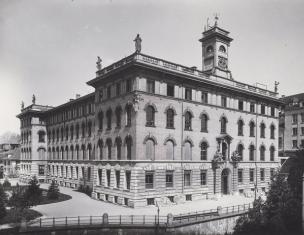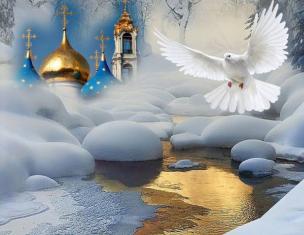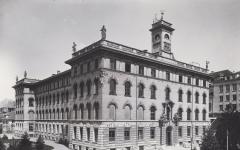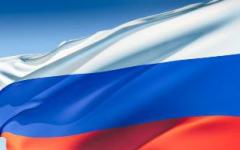The British Isles which are surrounded by the ocean have an insular climate.
There are 3 things that chiefly determine the climate of the United Kingdom: the position of the islands in the temperate belt; the fact that the prevailing winds blow from the west and south-west and the warm current - the Gulf Stream that flows from the Gulf of Mexico along the western shores of England. All these features make the climate more moderate, without striking difference between seasons. It is not very cold in winter and never very hot in summer.
So, the British ports are ice-free and its rivers are not frozen throughout the year. The weather on the British Isles has a bad reputation. It is very changeable and fickle. The British say that there is a climate in other countries, but we have just weather. If you don"t like the weather in England, just wait a few minutes.
It rains very often in all seasons in Great Britain. Autumn and winter are the wettest. The sky is usually grey and cold winds blow. On the average, Britain has more than 200 rainy days a year. The English say that they have 3 variants of weather: when it rains in the morning, when it rains in the afternoon, and when it rains all day long. Sometimes it rains so heavily, that they say «It"s raining cats and dogs».
Britain is known all over the world for its fogs. Sometimes fogs are so thick that it"s impossible to see anything within a few meters. The winter fogs of London are, indeed, awful; they surpass all imagination. In a dense fog all traffic is stopped, no vehicle can move from fear of dreadful accidents. So, we may say that the British climate has three main features: it is mild, humid and very changeable.
Климат в Великобритании
Британские острова, окруженные океаном, имеют островной климат.
В основном климат Великобритании определяют три фактора: расположение островов в умеренном поясе; факт того, что господствующие ветры дуют с запада и юго-запада; теплое течение Гольфстрим, которое течет из Мексиканского залива вдоль западного побережья Англии. Все это в совокупности, делает климат более умеренным, без большой разницы температур между сезонами. Здесь не очень холодно зимой и никогда не бывает жарко .
Так что Британские порты не сковываются льдом зимой, а реки не замерзают в течение года. Погода на Британских островах имеет плохую репутацию. Она очень изменчива и непостоянна. Британцы говорят, что в других странах есть климат, а у нас - погода. Если вам не нравится погода в Англии, подождите несколько минут.
В Великобритании идет очень часто и в любое время года. Самые влажные сезоны - и " . Небо обычно серого цвета, дуют холодные ветры. В среднем по Англии более 200 дождливых дней в году. Англичане говорят, что у них три погоды: когда идет дождь утром, когда идет дождь днем и когда идет дождь целый день. Иногда идет настолько сильный дождь, что они говорят «дождь льет как из ведра».
Англия известна во всем мире своими туманами. Иногда туманы настолько густы, что невозможно что-либо рассмотреть в нескольких метрах от себя. Зимние туманы Лондона, действительно, ужасны; они превосходят любое воображение. В очень сильном тумане останавливается весь транспорт, из-за страха попасть в ужасную аварию, любая машина вынуждена стоять. Так что мы можем сказать, что британский климат имеет три основных особенности: он умеренный, влажный и очень непостоянный.
Climate and Nature of Great Britain - топик на английском языке , который познакомит вас с природой Великобритании.
The climate in Great Britain is generally mild and temperate due to the influence of the Gulf Stream. The south-western winds carry the warmth and moisture into Britain. The climate in Britain is usually described as cool, temperate and humid.
British people say: "Other countries have a climate, in England we have weather."
The weather in Britain changes very quickly. One day may be fine and the next day may be wet. The morning may be warm and the evening may be cool. Therefore it is natural for the people to use the comparison "as changeable as the weather" of a person who often changes his mood or opinion about something. The weather is the favourite topic of conversation in Britain. When two Englishmen are introduced to each other, if they can"t think of any thing else to talk about, they talk about weather. When two people meet in the street they will often say something about weather as they pass, just to show their friendliness.
Every daily paper publishes a weather forecast. Both the radio and television give the weather forecast several times each day.
The English also say that they have three variants of weather: when it rains in the morning, when it rains in the afternoon or when in rains all day long. Sometimes it rains so heavily that they say "It"s raining cats and dogs".
Rainfall is more or less even throughout the year. In the mountains there is heavier rainfall then in the plains of the south and east. The driest period is from March to June and the wettest months are from October to January. The average range of temperature (from winter to summer) is from 15 to 23 degrees above zero. During a normal summer the temperature sometimes rises above 30 degrees in the south. Winter temperatures below 10 degrees are rare. It seldom snows heavily in winter, the frost is rare. January and February are usually the coldest months, July and August the warmest. Still the wind may bring winter cold in spring or summer days. Sometimes it brings the whirlwinds or hurricanes. Droughts are rare.
So, we may say that the British climate has three main features: it is mild, humid and changeable. That means that it is never too hot or too cold. Winters are extremely mild. Snow may come but it melts quickly. In winter the cold is humid cold, not the dry one.
This humid and mild climate is good for plants. The trees and flowers begin to blossom early in spring.
In the British homes there has been no central heating up till recently. The fireplaces are often used. but the coal is not used as it"s very expensive. Britain has no good coal now and imports it itself. Many schools and universities have no central heating either, and the floors there are made of stone. The British bedroom is especially cold, sometimes electric blankets or hotwater bottles are used.
VEGETATION AND WILDLIFE
Britain was originally a land of vast forests. mainly oak and beech in the Lowlands and pine and birch In the Highlands, with great stretches of marshland and smaller areas of moors. In the course of time, much forest land was cleared and almost all Lowlands outside the industrial areas were put under cultivation. Today only about 6 per cent of the total land area remains wooded.
Extensive forests remain in eastern and northern Scotland and in south-eastern and western England. Oak, elm, ash, and beech are the commonest trees in England, while Scotland has much pine and birch. The Highlands with thin soil are largely moorland with heather and grasses. In the cultivated areas that make up most of Britain there are many wild flowers, flowering plants and grasses.
The fauna or animal life of Britain is much like that of north-western Europe, to which it was once joined. Many larger mammals such as bear, wolf have been hunted to extinction, others are now protected by law. There are many foxes. Otters are common along rivers and streams, and seals live along much of the coast. Hedgehogs, hares, rabbits, rats and mice are numerous. Deer live in some of the forests in the Highlands of Scotland and England.
Some 230 kinds of birds live in Britain, and another 200 are regular visitors, many are songbirds. The most numerous are blackbirds, sparrow and starling. Robin Redbreast is the national bird of Britain. The number of ducks, geese and other water fowl has diminished during recent years.
There are many threats to wildlife and ecological balance around the coast. The biggest threat to the coastline is pollution. Even much-loved.
Blackpool is not officially asafe. More than 3.500 million tons of industrial waste is pumped into the North Sea every year. "We cannot continue to use our seas as a dustbin and expect our coastline to survive," says Greenpeace. Many other ecological problems may be caused by privatization of the coast. Many of the rivers are "biologically dead", i.e. unable to support fish and wildlife.
The climate in Great Britain is generally mild and temperate, due to the influence of the Gulf Stream. The southwestern winds carry the warmth and moisture into Britain. The climate in Britain is usually described as cool, temperate and humid. British people say: "Other countries have a climate, in England we have weather."
The weather in Britain changes very quickly. One day may be fine and the next day may be wet. The morning may be warm and the evening may be cool. Therefore it is natural for the people to use the comparison "as changeable as the weather" for a person who often changes his or her mood or opinion about something.
The weather is the favourite topic of conversation in Britain. When two Brits are introduced to each other, if they can"t think of anything else to talk about, they will talk about weather. When two people meet in the street, they will often say something weather-related as they pass, just to show their friendliness.
Every daily paper publishes a weather forecast. Both the radio and television give the weather forecast several times each day. The English also say that they have three variants of weather: when it rains in the morning, when it rains in the afternoon or when in rains all day long. Sometimes it rains so heavily that they say "It"s raining cats and dogs". Rainfall is more or less even throughout the year.
In the mountains there is heavier rainfall then in the plains of the south and east. The driest period is from March to June and the wettest months are from October to January. The average range of temperature (from winter to summer) is from 15 to 23 Celsius degrees above zero. During a normal summer the temperature sometimes rises above 30 degrees in the south. Winter temperatures below 10 degrees are rare. It seldom snows heavily in winter, and frost is rare. January and February are usually the coldest months, and July and August the warmest. Still the wind may bring winter cold in spring, or on summer days. Sometimes it brings whirlwinds or hurricanes. Droughts are rare.
So, we can say that British climate has three main features: it is mild, humid and changeable. That means that it is never too hot nor too cold. Winters are extremely mild. Snow may come but it melts quickly. In winter the cold is a humid cold, not of the dry variety. This humid and mild climate pattern is good for plants. Trees and flowers begin to blossom early in spring.
In British homes there has been no central heating up till recently. The fireplaces are often fired-up, but coal is not used as it"s very expensive, so people use wood instead for fireplaces. Britain doesn"t have any high-grade coal, and has to import it into the country. Many schools and universities don"t have any central heating either, and the floors there are made of stone. The typical British bedroom is especially cold, and sometimes electric blankets or hotwater bottles are used.
Britain was originally a land of vast forests, mainly oak and beech in the Lowlands and pine and birch in the Highlands, with broad stretches of marshland and smaller areas of moors. Over the course of time, much of the forest land was cleared and almost all Lowlands outside the industrial areas were cultivated. Today only about 6 per cent of the total land area remains wooded. Extensive forests remain in eastern and northern Scotland and in southeastern and western England. Oak, elm, ash, and beech are the commonest trees in England, while Scotland has a lot of pine and birch. The Highlands are largely moorland with heather, grasses and shallow soil.
In the cultivated areas that make up most of Britain, there are many wild flowers, flowering plants and grasses. The fauna or animal life of Britain is much like that of northwestern Europe, which the UK used to be a part of. Many larger mammals such as bear and wolf have been hunted to extinction, while others are now protected by law. In addition, there are many foxes. Otters are common along rivers and streams, and seals live along much of the coast. Hedgehogs, hares, rabbits, rats and mice are numerous. Deer live in some of the forests in the Highlands of Scotland and England. Some 230 species of birds live in Britain, and another 200 varieties are regular visitors, many are songbirds. The most numerous are blackbirds, sparrow and starling. Robin Redbreast is the national bird of Britain. The number of ducks, geese and other water fowl has diminished during recent years. There are many threats to both the wildlife and ecological balance around the coast. The biggest threat to the coastline is pollution. Even much-loved Blackpool is not officially safe. More than 3.500 million tons of industrial waste is pumped into the North Sea every year. "We cannot continue to use our seas as a dustbin and expect our coastline to survive," says Greenpeace. Many other ecological problems may be caused by privatization of the coast. Many of the rivers are "biologically dead", and therefore unable to support fish and wildlife.
The Climate of Great Britain (1)
Great Britain is situated on islands. It is washed by seas from all sides. That"s why the climate and the nature of Great Britain is very specific. The popular belief that it rains all the time in Britain is simply not true. In fact, London gets no more rain in a year than most other major European cities. Generally speaking, the further west you go, the more rain you get. The mild winters mean that snow is a regular feature of the higher areas only. The winters are in general a bit colder in the east of the country than they are in the west. While in summer, the south is slightly warmer and sunnier than the north. Besides Britain is famous for I fogs. Sometimes fogs are so thick that it is impossible to see anything within 2 or 3 metres.
Why has Britain"s climate got such bad reputation? Maybe it is for the same reason that British people always seem to be talking about the weather. There is a saying that Britain doesn"t have a climate, it only has weather. You can never be sure of a fry day, though it may not rain very much altogether. There can be cool and even cold days in July and some quite warm days in January.
The weather changes very often. Mark Twain said about America: "If you like the weather in New England, just wait a few minutes" but it is more likely to have been said about England. The lack of extremes is the reason why on the few occasions when it gets genuinely hot or freezing cold, the country seems to be totally unprepared for it. A bit of snow, a few days of frost and the trains stop. working and the roads are blocked. If the thermometer goes above 2ГС, people behave as if they were in Sahara and the temperature makes front-page headlines. These things happen so seldom that it is not worth organizing life to be ready for them. Everyone who comes to Great Britain says that it looks like one great beautiful park. The British people love their country and take care of it.
Климат Великобритании (1)
Великобритания расположена на островах. Со всех сторон она омывается морями. Поэтому климат и природа Великобритании очень специфичны. Распространенное мнение о том, что в Британии все время идет дождь, не совсем верное. На самом деле в Лондоне за год выпадает не больше осадков, чем в большинстве других европейских городов. В целом, чем дальше на запад, тем количество осадков больше. Мягкие зимы предполагают наличие снега только на возвышенностях. Зимы в общем более холодны на востоке страны, чем на западе. В то же время летом на юге теплее и солнечнее, чем на севере. Кроме этого, Британия знаменита своими туманами. Иногда туманы такие густые, что невозможно что-нибудь увидеть на расстоянии 2 или 3 метров.
Почему климат Британии имеет такую плохую репутацию? Может быть, это потому, что британцы, кажется, постоянно говорят о погоде. Существует поговорка, что Британия не имеет климата, она имеет только погоду. Вы никогда не можете быть уверены, что будет сухой день, хотя может и не быть сильного дождя. Могут быть прохладные и даже холодные дни в июле и теплые дни в январе.
Погода меняется очень часто. Марк Твен сказал про Америку: "Если вам не нравится погода в Новой Англии, подождите несколько минут", но это больше похоже на сказанное про Англию. Отсутствие резких контрастов - причина того, что в некоторых случаях, когда становится очень жарко или холодно, страна кажется неподготовленной к этому. Немного снега и несколько дней мороза - и перестают ходить поезда, а дороги оказываются заблокированными. Если термометр показывает больше 2ТС, люди ведут себя, как в Сахаре, а температура воздуха становится темой первых страниц газет. Но эти вещи случаются так редко, что нет смысла специально к этому готовиться. Каждый, кто приезжает в Англию, говорит, что она выглядит как один большой красивый парк. Англичане любят свою страну и заботятся о ней.
Questions:
1. Why is the
climate and the nature of Great Britain very specific?
2. What is Britain famous for?
3. Why has Britain"s climate got such a bad reputation?
4. The weather in Britain is very changeable, isn"t it?
5. Does it rain often?
Vocabulary:
feature - особенность
genuinely - неподдельно
fog - туман
headline - заголовок
The United Kingdom of Great Britain and Northern Ireland is situated on the British Isles and lies to the north-west of continental Europe. It is separated from the continent by the English Channel and the Strait of Dover in the south and the North Sea in the east. In everyday speech the term “Great Britain” is often applied to the United Kingdom as a whole.
The British Isles consist of two main islands (Great Britain and Ireland) and a large group of smaller islands. Great Britain is separated from Ireland by the Irish Sea. Historically the territory of Great Britain is divided into 3 parts: England, Scotland and Wales. It doesn’t include Northern Ireland. The population of Great Britain is over 60 million people. The total area is 209 000 km 2 (two hundred and nine thousand square kilometers).
The British landscape is very varied. Geographically the island of Great Britain is made up of three main regions: Lowland, Midland and Highland Britain. The Midlands occupy central counties of England. This is a region of valleys and low hills. Lowland Britain covers the territory of eastern and southern England. Highland Britain comprises Scotland, most of Wales, the Pennine Chain and the Lake District in England. Scotland and Wales are the most mountainous parts of Great Britain. Ben Nevis in Scotland is the highest point (1343 metres). Along the western coast runs the mountain range of Cumberland. The Cheviot Hills mark the boundary between England and Scotland.
The rivers in Great Britain are quite short and most of them flow in the eastward direction. The rivers (the Thames, the Severn, the Tweed, the Trent, the Tyne) never freeze in winter and allow all-year navigation.
Перевод
Соединенное Королевство Великобритании и Северной Ирландии расположено на Британских островах и лежит к северо-западу от континентальной Европы. От континента его отделяют пролив Ла-Манш и Па-де-Кале на юге и Северное море на востоке. В повседневной жизни термин «Великобритания» часто применяется ко всему Соединенному Королевству в целом.
Британские острова состоят из двух основных островов (Великобритании и Ирландии) и большой группы малых островов. Великобританию отделяет от Ирландии Ирландское море. Исторически территория Великобритании разделена на три части: Англию, Шотландию и Уэльс. Она не включает в себя Северную Ирландию. Население Великобритании превышает 60 миллионов человек. Общая территория составляет 209 000 кв.км.
Британский ландшафт очень разнообразен. Географически остров Великобритании сложился из трех основных местностей: низменности, средней полосы и высокогорья Британии. Средняя полоса занимает центральные графства Англии. Это местность с долинами и низкими холмами. Низменность Британии покрывает территорию восточной и южной Англии. Высокогорная Британия состоит из Шотландии, большей части Уэльса, Пеннинских гор и Озерного края в Англии. Шотландия и Уэльс являются наиболее гористыми частями Великобритании. Бен Невис в Шотландии – это самая высокая точка (1343 метра). Вдоль западного побережья пролегает горная цепь Камберленд. Горы Чевиот-Хилс отмечают границу между Англией и Шотландией.
Реки Великобритании довольно коротки, и большая их часть течет в восточном направлении. Реки (Темза, Северн, Твид, Трент, Тайн) никогда не замерзают зимой и допускают круглогодичную навигацию.








